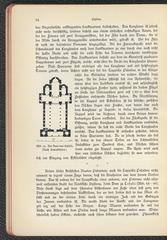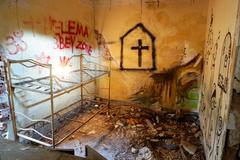
Cefalù Cathedral Visiting Hours, Tickets, and Historical Sites Guide
Date: 14/06/2025
Introduction
Cefalù Cathedral (Duomo di Cefalù) is a monumental symbol of Sicily’s rich, multicultural history. Commissioned in 1131 by Roger II, the first Norman King of Sicily, the cathedral stands at the heart of Cefalù, merging Norman, Arab, and Byzantine traditions. Its fortress-like façade, exquisite mosaics—most notably the Christ Pantocrator—and its UNESCO World Heritage status as part of the “Arab-Norman Palermo and the Cathedral Churches of Cefalù and Monreale” make it an essential destination for history enthusiasts, art lovers, and travelers. This guide provides detailed information on visiting hours, ticketing, architectural highlights, accessibility, and nearby attractions, ensuring you make the most of your visit to this Sicilian masterpiece.
For additional information, consult Culture Activities, Study.com, and Visit Cefalù.
Table of Contents
- Historical Overview and Architectural Significance
- Visitor Information: Hours, Tickets, and Accessibility
- What to See: Key Features and Artistic Highlights
- Nearby Attractions and Practical Tips
- FAQs
- Conclusion
- References
Historical Overview and Architectural Significance
Origins and Construction
Founded in 1131 by Roger II after surviving a storm at sea, Cefalù Cathedral was both a personal vow and a political statement asserting Norman-Christian rule over a region with a diverse heritage (great-sicily.com). The construction spanned over a century, with key phases completed by 1240 and consecration in 1267, and later additions such as the bell towers and portico in the 15th century (study.com).
Architectural Fusion
Cefalù Cathedral is a quintessential example of Norman-Arab-Byzantine architectural synthesis (Wonders of Sicily).
- Norman elements are visible in the fortress-like exterior and twin towers.
- Arab (Islamic) influences appear in pointed arches, ribbed vaults, and geometric motifs (cultureactivities.com).
- Byzantine artistry shines in the lavish mosaics, particularly the Christ Pantocrator in the apse (sheknowsislands.com).
UNESCO World Heritage Status
Recognized in 2015 as part of the Arab-Norman Palermo and the Cathedral Churches of Cefalù and Monreale, the cathedral is celebrated for its role in reflecting Sicily’s unique cultural syncretism (visitcefalu.com).
Visitor Information: Hours, Tickets, and Accessibility
Location
The cathedral is centrally located in Piazza del Duomo, accessible by foot from anywhere in Cefalù’s historic center (visitcefalu.com; earthtrekkers.com).
Visiting Hours
- Daily: 8:30 AM – 1:00 PM and 3:00 PM – 7:00 PM
(Hours may vary during religious events or holidays. Always check the official website before your visit.)
Admission and Ticket Options
- Main Nave: Free entry
- Towers, Cloister, Museum, Rooftop Access: Ticket required
- Red Itinerary (Full Tour): €10 (towers, roofs, mosaics, sacristy, museum, cloister)
- Blue Itinerary: €7 (towers, roofs, under mosaics view)
- Other options: €8–€13, with reductions for youth and children (visitcefalu.com)
- Tickets: Purchase onsite or online via the official website.
Accessibility
- Wheelchair ramps provide access to the main nave.
- Some areas (towers, rooftops, cloister) have stairs and uneven surfaces.
- Assistance available upon request.
Guided Tours
- Available in multiple languages.
- Offer in-depth historical and artistic context.
- Book in advance, especially in high season.
What to See: Key Features and Artistic Highlights
Exterior and Entrance
- Façade: Twin 15th-century towers and a three-arched portico with cross vaults (tripstosicily.com).
- Porta Regum: Ornate marble portal introducing the cathedral’s grandeur.
Interior
- Latin Cross Layout: Three naves divided by granite columns.
- Byzantine Mosaics:
- The apse is adorned with over 600 m² of mosaics, crafted by Constantinople artisans (1148–1166).
- The Christ Pantocrator, framed by the Virgin Mary and four archangels, is a highlight and central to the cathedral’s UNESCO recognition (earthtrekkers.com).
- Mosaics extend to the presbytery, choir, and side walls, forming a comprehensive theological program (Web Gallery of Art).
Cloister and Museum
- 12th-century Cloister: Oldest in Sicily, with paired columns and intricately carved capitals (Wonders of Sicily).
- Museum/Sacristy: Exhibits on the cathedral’s history and sacred art.
Towers & Rooftop Terraces
- Climb for panoramic views of Cefalù, the cathedral, and the sea (note: views are partially screened by safety netting) (earthtrekkers.com).
Religious Services
- The cathedral is an active church. Check the mass schedule when planning your visit.
Nearby Attractions and Practical Tips
Piazza Duomo
The social heart of Cefalù, lined with cafés and restaurants—ideal for relaxing with a view of the cathedral (Along Dusty Roads).
Medieval Old Town
Wander cobbled alleys, artisan shops, and historic sites, including the Lavatoio Medievale (ancient wash house) (Life Beyond the Wire; Traveling Italian).
La Rocca di Cefalù
A 270m-high crag with hiking trails, ruins of a Norman castle, and the ancient Temple of Diana. Entry: €5 (Go Ask a Local).
Cefalù Beach
A 1.6km stretch of golden sand just steps from the cathedral—perfect for swimming and sunbathing (Salt in Our Hair; Tourist Places Guide).
Museo Mandralisca
Eclectic museum with art, archaeology, and the famous Portrait of an Unknown Man by Antonello da Messina (Along Dusty Roads).
Dining and Local Events
Try local cuisine at trattorias, sample gelato, or visit during festivals such as Carnival, Holy Week, or the Patron Saint’s Day (Traveling Italian; Life Beyond the Wire).
Practical Tips
- Dress Code: Shoulders and knees covered (especially if combining with beach visits).
- Photography: Allowed in most areas; flash/tripods may be restricted (earthtrekkers.com).
- Best Times: Early morning or late afternoon for fewer crowds.
- Duration: Allocate 1–2 hours for the cathedral; half a day if including nearby attractions.
FAQs
Q: What are the Cefalù Cathedral visiting hours?
A: 8:30 AM–1:00 PM and 3:00 PM–7:00 PM daily. Check for variations on holidays.
Q: Is there an entrance fee?
A: Main nave free; tickets required for towers, museum, cloister, rooftops.
Q: Where can I buy tickets?
A: Onsite or online at the official website.
Q: Are guided tours available?
A: Yes, in multiple languages. Advance booking recommended.
Q: Is the cathedral accessible?
A: Main nave accessible; towers/rooftop may be difficult for those with reduced mobility.
Q: What else is nearby?
A: Medieval old town, La Rocca, Museo Mandralisca, Lavatoio Medievale, Cefalù beach.
Conclusion
Cefalù Cathedral is a masterpiece of Norman-Arab-Byzantine art and architecture, standing at the crossroads of history, faith, and culture. With its world-renowned mosaics, harmonious blend of styles, and vibrant surroundings, it offers an unforgettable Sicilian experience. Plan your visit by checking updated hours and ticket options, and consider exploring the old town, La Rocca, and local museums for a full immersion into Cefalù’s heritage. For up-to-date information and travel tips, visit the official cathedral website, and enrich your trip with mobile guides and local insights.
References
- Culture Activities
- Study.com
- Great Sicily
- Wonders of Sicily
- Visit Cefalù
- Earth Trekkers
- Web Gallery of Art
- Traveling Italian
- TripstoSicily
- Along Dusty Roads
- Life Beyond the Wire
- Go Ask a Local
- Salt in Our Hair
- Tourist Places Guide

